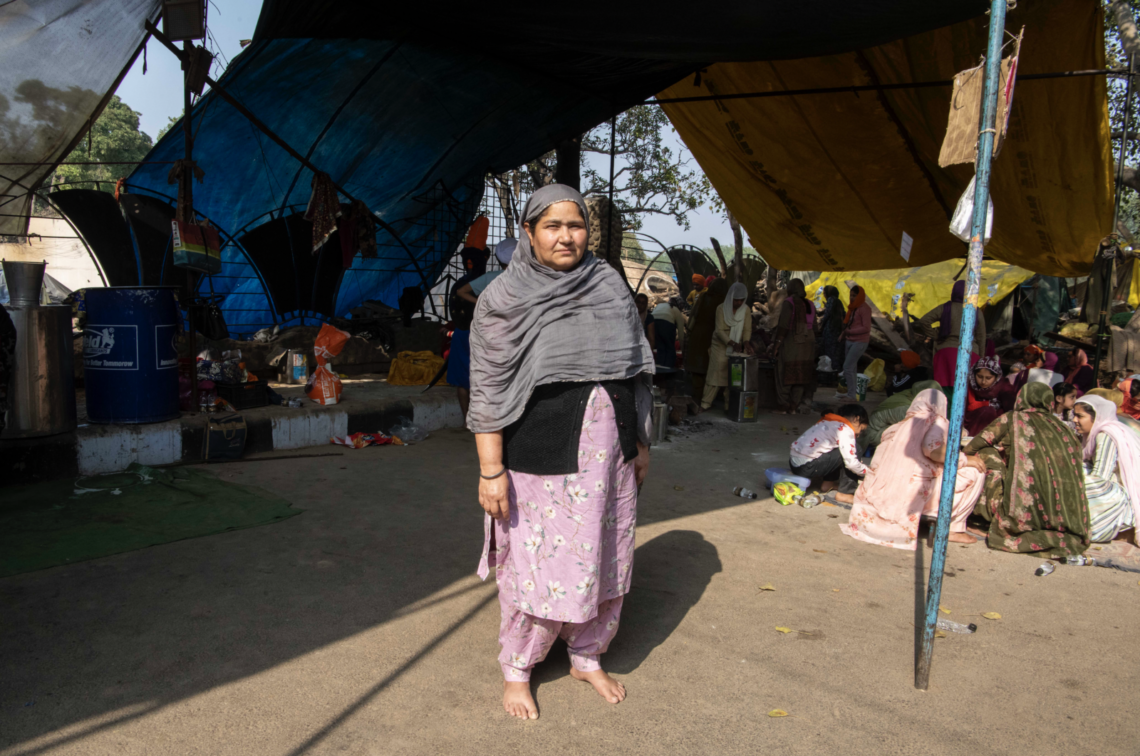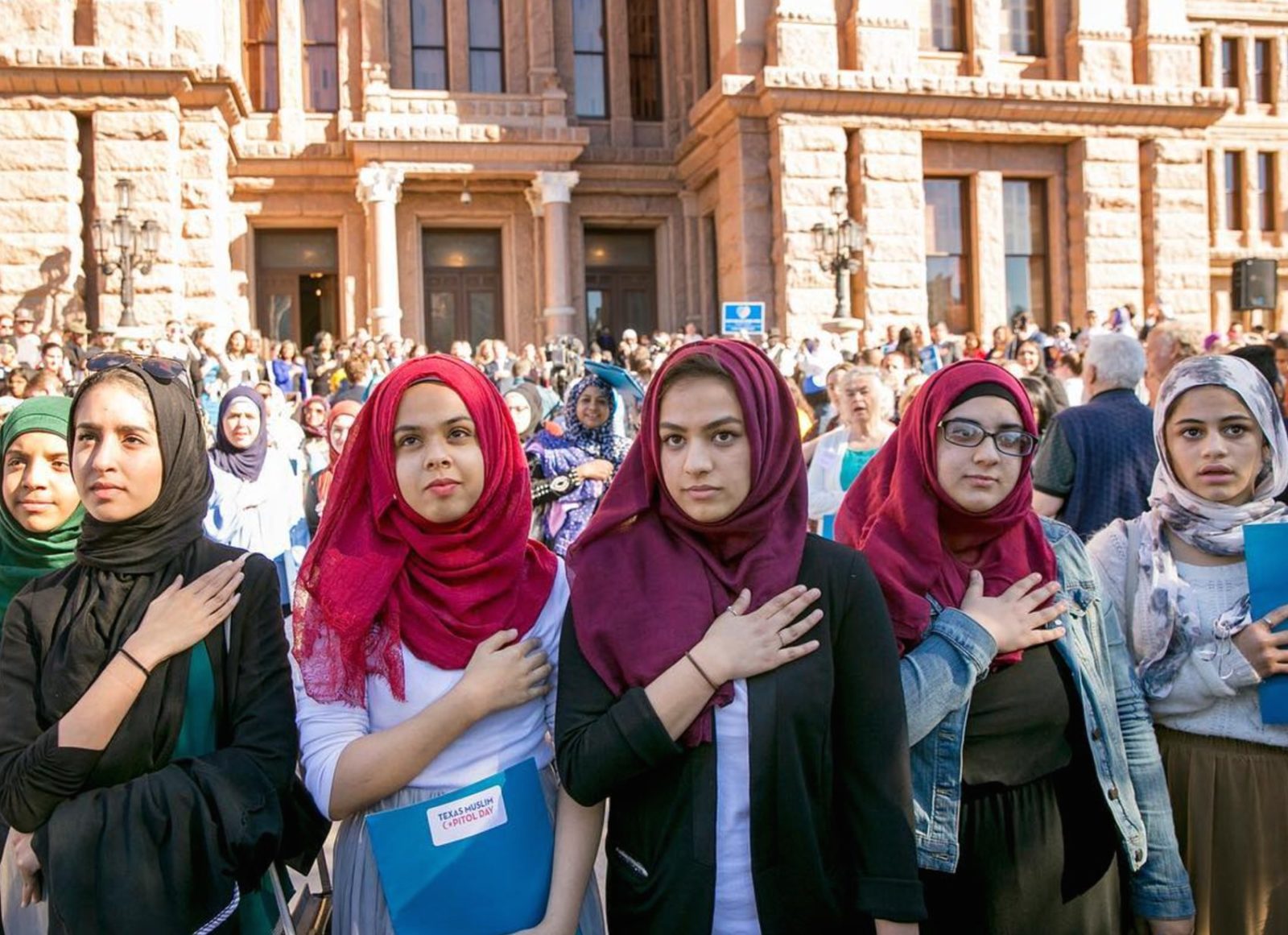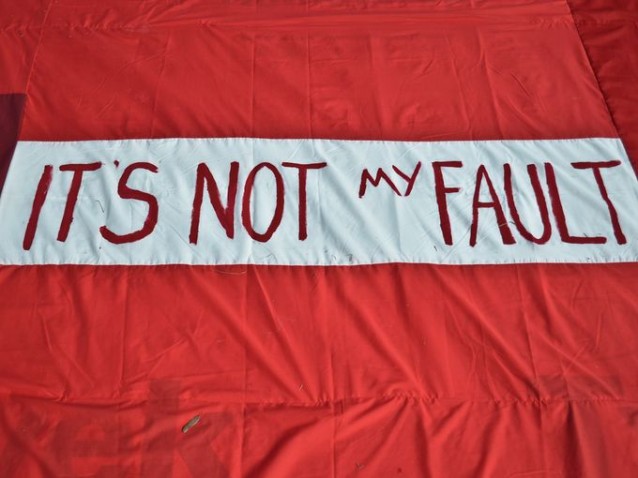By Rohit Lohia
Content note: mentions of violence and sexual assault.
Introduction by Lakhpreet Kaur: Writer Rohit Lohia interviews Rajinder Kaur – a 48 years old woman from Mohali who is currently at the Quami Insaaf Morcha protest.
Background: In Punjab, India on January 7, 2023, with the name of Qaumi Insaaf Morcha (Sikh Nation Justice Protest) various Sikh organizations started a protest for the release of Sikh prisoners who have completed their sentences. The issue of their release has been a central issue for Punjabis for some time but recently, political parties and organizations have highlighted the matter.
The Shiromani Gurdwara Parbandhak Committee has formed a list of 21 Sikh prisoners who are yet to be released. However, the focus of the Qaumi Insaaf Morcha is on nine prisoners who have already completed their sentences – which were anywhere from 15 to 31 years in jail.
Note: Article was researched and written prior to February 22, 2023. Events occuring after that date are not covered.
Remembering the anti-Sikh violence of 1984
“That night, while my father was riding his bicycle, he was killed by the military. There used to be huge curfews and while he was going to meet my older sister at her law’s home, he was shot point-blank multiple times by the military.
It was after Indira Gandhi’s killing, I was in 7th standard (grade) at the time but still remember his face, his voice and how we went through the time with no earning member left in the home. I remember everything.”
A woman in her late 40s wearing a pink suit and shawl over her head sits near the big cooking pan and recalls the darkest period for the Sikh community and her life in recent history. The year was 1984 and thousands of Sikhs were killed as the wave of “Kharku (freedom fighter) Sikhs” reached the national capital and killed former Prime Minister Indira Gandhi. (Kharku Sikhs were militant Sikhs demanding a separate state of Punjab from India.)
As she turns the roti on the pan, she continues, “My brother, who is 2 years older than me, was harassed by the police to a great extent. He was picked up many times from home, detained without any proof, and my father was killed. All burden of managing the home was on my mother who survived on farming. My mother has been through a lot of struggle.”

Rajinder Kaur Joins the Qami Insaaf Morcha
A daughter of a farmer and sibling of 5 sisters and 1 brother, Rajinder Kaur (48 yrs, Mohali) sits among the hundreds of other women joining the Quami Insaaf Morcha at Chandigarh-Mohali border to demand the release of Bandi Singhs- Sikh prisoners who have completed their life sentences but have not yet been released.
Kaur has been joining the sit-in protest since its inception on 7th Jan, 2023 when a group of activists gathered under the aegis of the banner of Quami Ensaaf Morcha to demand the release of Bandi Singhs– Sikh prisoners who have completed their life sentences but have not yet been released. Activists gathered at the historical Amb Sahib Gurdwara in Punjab’s Mohali to march towards Chandigarh. The agitators however were stopped at the Chandigarh-Mohali border at the Dolphin Chowk near Yadavindra Public School, one of the main arterial roads from Chandigarh to Punjab. Here the march has transformed into a pakka morcha (semi-permanent protest/sit-in). Based on the model of the farmers’ movement back in 2020-21, Singhs and Kaurs have set up their makeshift tents and established langar while trolleys laden with rations have become home for many.
As the chants of Raj Karega Khalsa and Jo Bole So Nihal- Sat Sri Akal from the stage whenever someone finishes the speech reaches the langar area where Rajinder is sitting, she comes back from a dark blank space, “My father was a religious person, he was very close to me. His face is always in front of my eyes. It was hard, really hard.
My brother who was picked up and detained multiple times was beaten badly and tortured to the extent he still has mental issues. He has lost his mental stability, we Sikhs have always been subjected to great atrocities.”
Rajinder runs a boutique store which she has kept closed since the morcha has begun to be a part of the sit-in protest. Having lost an income of almost 50,000 rupees, she feels the service of langar is her calling, saying, “My religion is the priority for me, children and family come later, after the Guru and service for them. Even after getting back home, I am thinking of this morcha. I come early in the morning around 7am and leave around 9 pm. My work involves service here, to prepare langar which I feel like is the foremost thing Sikhi teaches me about.”
Sikhi Inspires Rajinder Kaur
Rajinder, who is a mother of two children, comes every day to the morcha with her family. Leaving other family members and her livelihood behind, she has found a large community of friends among the women at the sit-in site. As she turns over another chapati on the cooking pan, she tells what keeps her motivated as a Sikh woman:
“Satnam Waheguru gives me strength. Looking up to [the Gurus], and reading [Gurbani] gives us strength and fills me with zeal to stand against anything which we Sikhs have been through. This government (BJP political party in power) is committing atrocities against us Sikhs, they say the law is equal for everyone. But is it? Ram Rahim who was convicted of rape and murder has been released in the middle of his sentence; they have let go a rapist and claim our people, who have completed their sentences a long time back, are terrorists. Our people have been behind the bars for last 30-32 years, are they still terrorists? The government, for votes, has acquitted such a filthy person like Ram Rahim, but our Bandi Singhs are still behind the bars. It fills me with rage.”
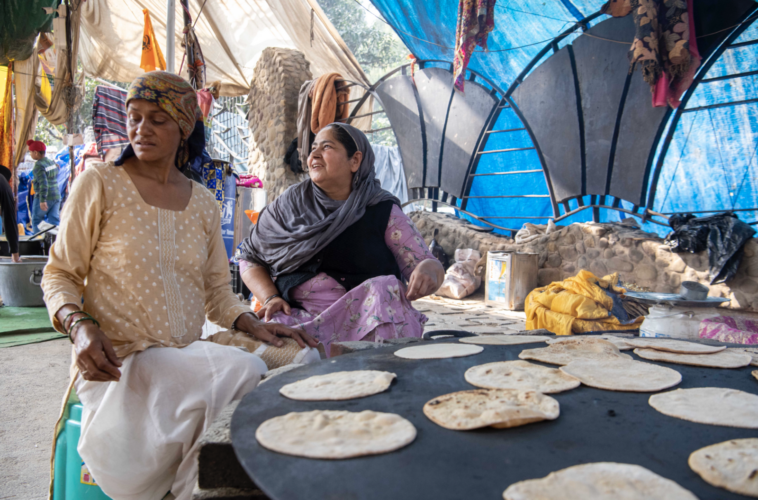
Politics Divide India
Since the Hindu-nationalist government came to power in 2014 and was re-elected in 2019, attacks and atrocities against religous minorities in India have risen exponentially. Rajinder was recalling the atrocities while also being subjected the current political environment. She crossed her arms saying she feels, “Only Guru Sahib can cure today’s pollution. Only Maharaj [Guru Gobind Singh Ji] can make the government understand with his stick. They can’t understand like this.”
She continues, “Sikhs are people who carry everyone with them, our religion is engraved in inclusivity. We carry everyone alongside us, be it Hindus, Muslims, or Christians. But this regime, ruled by rightist Prime Minister Modi is carrying out divisive politics on the ground, creating communal tensions. Filling people with hatred so that they fight and kill each other. But all are brothers-sisters for us.”
I saw she was aware of politics and worried about the nation’s condition. I asked her what outcome she hopes for, leaving her livelihood and family, “I don’t have trust or hopes from any kind of government. If things don’t change now, our conditions will be worse in the future. So I hope this morcha results in nothing less than to get the Singhs released; I will be here until they are released. Our Guru will listen to us and make us successful.”
Women Are a Must Any Kind of Movement
Adamant to get justice and close down the boutique store if need be, Rajinder feels her presence along with hundreds of other women is a crucial part of any movement. Adjusting her shawl, she turns towards us, and hands over the tongs to another woman. Rajinder says, “Women are a must in any kind of movement. It is a woman who has given birth to a man. Women play an essential role in keeping the people fed, a man is incomplete without a woman. Just like a man is incomplete without a life partner, any movement is incomplete without the presence of women.”
The Start of the Bandi Singh Release Movement
The movement for the Bandi Singhs started in Punjab in 2013 when the demand was first raised to release Sikh militants who had been jailed during the state’s period of militancy in the 1980s and 1990s and had been incarcerated for decades. Some of the political prisoners of Bandi Singh are the people who were convicted of killing former Punjab Chief Minister Beant Singh and others were charged for the bomb blasts during the violence in 1984. Most of them have been charged with terrorism under the Terrorist and Disruptive Activities (Prevention) Act ( TADA) or Explosive Substances Act, or charged with murder, attempt to murder, and/or conspiracy.
Having lost income of 50,000 ruppes during this whole period, I asked I asked Rajinder how would she cope with the losses, “I will shut down the shop if need be. It is the government’s loss, a loss to the reputation of the Modi-Shah regime in the whole world. Our relatives from other countries call us and tell, us how it is defaming the government among the diaspora.”
Police Intimidate Protestors
As another Kaur interjects; she mentions how the police are intimidating the protestors. Rajinder adds, “The son of one of my relatives has been picked up and arrested for several days now in an atempt to host a rally for this movement. We hear that protestors are getting calls from the police in our native villages telling them not to be a part of the morcha or they will be prosecuted. You can ask anyone here, they or someone they know have received such threatening calls from the police.”
“We are not begging here, we are asking for justice.”
Having befriended other women, Rajinder laughs with them while cooking the chapatis. As the Gurbani starts from stage, which has transformed into a gurudwara, Rajinder says “Ik Onkar” and turns to us. She says, “Asking for our rights is a necessity. It is my religion which encourages me to fight against any kind of injustice. Our Gurus say it is a sin to commit atrocities or be subjected to one.”
The chants of Sat Sri Akal sound as people have food. Rajinder points out towards them and continues, “Guru Granth Sahib is my God. Offering Nitnem is essential for me. I offer Rehras during Anand Sahib prayers.”
While winding down the interview, Rajinder mentions that during a confrontation between protestors and the police, she was hurt by a stone hurled towards her by police personnel. “On February 8, we going towards the Chief Minister’s (CM) house, as a daily ritual.” She points towards her feet, “Look at my leg, it is still swollen. I was hurt by a stone which was hurled by people rallying against us; I believe there were called in by the police, because why would anyone have a problem with us? While marching, the police also confronted us with water cannons, lathi-charged, and used tear shells. The whole confrontation started when we asked the police to let us march to CM’s house – which is a democratic act. But we were stopped and after waiting for a couple of hours, requested and demanded. Police charged at us with batons. They beat our children badly. But, I still go serve langar to police officials and offer them food.”
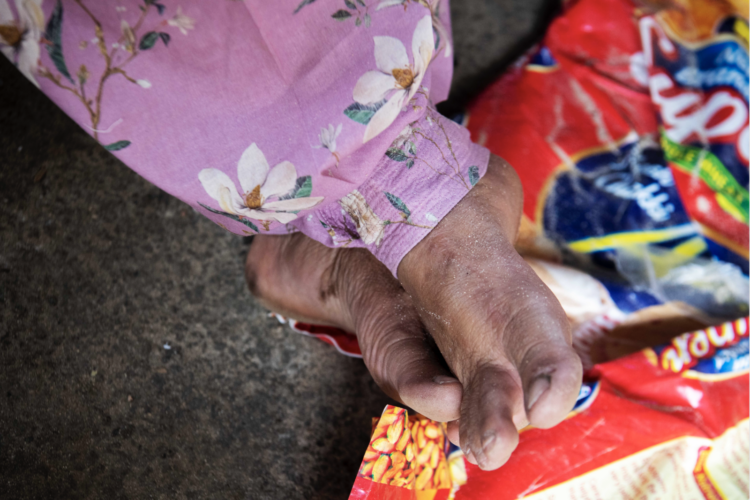
While mostly a peaceful movement, the protest has seen a couple of confrontations with the authorities. On January 18, some protesters attacked the vehicle of SGPC Chief Harjinder Singh Dhami when he visited the dharna site, he escaped unhurt. On February 8, a group of protesters and Nihangs, including some riding horses, clashed at the police while trying to enter Chandigarh to hold a demonstration outside Punjab Chief Minister Bhagwant Mann’s residence to highlight their demands. Punjab Police has since increased surveillance of the site, even deploying bullet-proof tractors there.
Leadership Held by Singhs & Nihangs
While women may be an important part of the movement, leadership is mainly held by the Singhs and Nihangs who have set up their camps at the forefront of the morcha which remind many of the farmers’ movement model. Rajinder feels, “Women, were not educated and were deprived of the facilities earlier. But now women are far ahead of men.”
“Women of Punjab don’t want to be at the forefront,” she believes. “They feel like it will be an insult to the patriarch of the family. We do walk beside the men of the family, but when it comes to being in the leadership it is men I want to see.”
Drawing from the Farmer’s Movement
The protest has taken shape similar to the farmers’ movement as tents are set up with tractors and mobile washrooms are installed. Kaur says, “There’s a temple nearby, people from the temple are helping us, allowing us to take baths and use washrooms. Apart from that, we have mobile washrooms. Here, accommodating the toilet facilities isn’t a problem.”
She adds, “I feel government unnecessarily makes people suffer. They anyhow bend later on, like with the farmers’ movement. They took the laws back after causing hundreds of deaths and making us suffer in extreme conditions for almost a year. We will not move from here also, be it 4 days or 4 years. We will go back to our homes with our Singhs released.”
A Message for the Diaspora
As we conclude the interview, I asked Rajinder what message she would like to give to the Sikh diaspora or the people who are still at home. Rajinder says, “Children outside the country should call their parents and ask them to join the movement. Conscience is supreme; the ones who are with the conscience are here or will come. People are supporting in their own manner, everyone has their reasons [for not coming] or obligations [that prevent them]. So those who can come are joining the morcha.”
While we sit beside her to have the langar, and she serves hot chapatis. The day starts to take its final moments, Rajinder bids us farewell saying, “Fal Neeveya Rukha Nu Lagde, Ucha Ho Ke Maan Na Kari“* meaning, “Do not be proud of your status. Always be humble.”
About Rohit Lohia
Rohit Lohia is a photographer and writer based out of New Delhi, India. Lohia’s work explores the connections between social injustice, human rights, gender conformity, mental health, notion of belonging, and communities subjected to discrimination and marginalization is his home nation of India.
He has been published in The Caravan, The Telegraph, Associated Press, The National UAE, and more.
*The expression, “Fal Neeveya Rukha Nu Lagde, Ucha Ho Ke Maan Na Kari” literally translate to, “Short trees bear fruit. You should not be prideful simply because you are tall.” It references the Gurbani line:
ਸਿੰਮਲ ਰੁਖੁ ਸਰਾਇਰਾ ਅਤਿ ਦੀਰਘ ਅਤਿ ਮੁਚੁ॥ ਓਇ ਜਿ ਆਵਹਿ ਆਸ ਕਰਿ ਜਾਹਿ ਨਿਰਾਸੇ ਕਿਤੁ॥
siṁmal rukh saraairaa at deeragh at much. oi ji aavahi aas kar jaahi niraase kit.
“The simmal (silk cotton) tree is straight as an arrow, very tall and very thick. Then, why do those birds, which visit it hopefully, depart disappointed?” – Guru Nanak Sahib, Guru Granth Sahib, 470
Gurbani Word of the Day interpert this as, “Taking the birds’ viewpoints as an example, the Guru says: A simmal tree is as straight as an arrow, very tall and thick. But the birds which come to sit on it return disappointed. Why? Because its fruits are tasteless, its flowers are nauseating, and its leaves are useless for the birds. What use is its height and thickness then, if it is not of any use to anyone? Are not those trees better, which are low and small, yet bear beautiful flowers and sweet fruits?”
According to Dr. Mohan Singh Dhariwal, Kaur Life advisor, in some cases, people would insert their own lyrics into shabads, serving as a dharna (chorus). This was one such expression that was/is inserted into kirtan. It was believed that using simplified, common language would help explain the shabad it accompanied. This practice was done quite freely in the past but has since died down in popularity as people are becoming more conscious of preserving the originality of Gurbani.
The line, “Fal Neeveya Rukha Nu Lagde, Ucha Ho Ke Maan Na Kari” was often inserted into the Asa Kir Vaar shabad, ਮਿਠਤੁ ਨੀਵੀ ਨਾਨਕਾ ਗੁਣ ਚੰਗਿਆਈਆ ਤਤੁ॥ mithat neevee naanakaa gun changiaaieeaa tat || “Sweetness and humility are the essence of virtue and goodness”.

